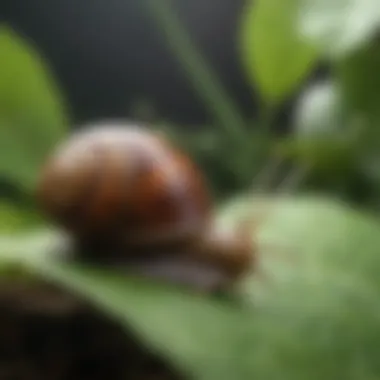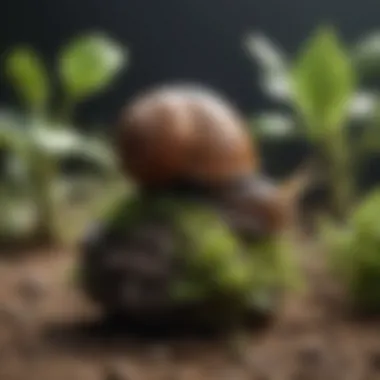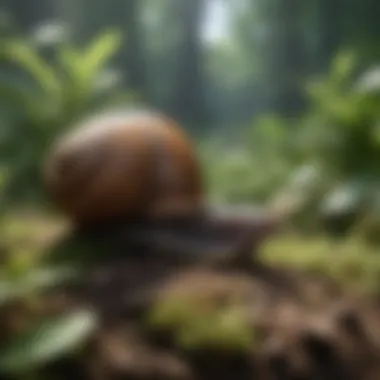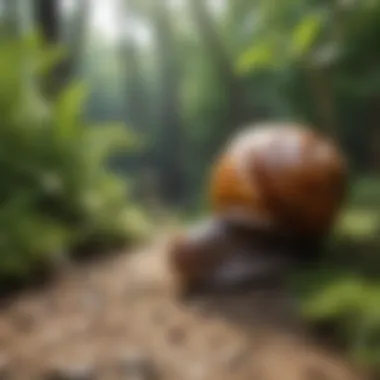Effective Strategies for Eliminating Snails from Gardens


Intro
A garden is a sanctuary for many people. Yet, it can quickly turn into a battlefield against pests, particularly snails. Their presence not only damages plants but also disrupts the natural beauty of your garden. Understanding effective strategies to eliminate snails is crucial for any gardening enthusiast. This article provides a detailed examination of the methods available for permanently managing snail populations, ensuring a more vibrant garden.
The Behavior of Snails
To combat snails effectively, one must first understand their habits. Snails are nocturnal and prefer damp environments. They feed primarily on softer leaves, which puts young plants at high risk. During the day, they hide in shaded areas or underground. Knowing these behaviors can inform the timing and type of methods used for control.
Impact of Snail Infestations
A significant infestation can devastate a garden. Plants may suffer from stunted growth, and entire crops can be lost. Furthermore, snails can attract other pests or lead to fungal diseases due to the moisture they bring. Recognizing their impact can motivate gardeners to take action.
Integrated Pest Management Approach
An integrated approach combines various methods to tackle snail issues holistically. This includes physical, chemical, and preventive strategies to ensure long-term results.
Physical Methods
Physical barriers can be highly effective. Here are some options to protect your garden:
- Copper Tape: Snails do not cross copper due to a reaction to their slime.
- Eggshells: Crushed eggshells create sharp barriers that snails avoid.
- Diatomaceous Earth: This powder can deter snails as it damages their soft bodies.
Chemical Methods
While it's best to rely on sustainable methods, specific chemicals may be necessary in severe infestations. When choosing chemical treatments, consider options that are less harmful to other wildlife.
Important: Always read labels and apply chemicals responsibly.
Preventive Measures
Prevention is often the best strategy. Here are several tactics to keep snails at bay:
- Regular Maintenance: Clear debris, and avoid overwatering to reduce damp areas that attract them.
- Plant Selection: Opt for resistant plants. Some plants are less attractive to snails.
- Companion Planting: Use plants that repel snails. For instance, lavender and rosemary can deter these pests.
Ending
The battle against snails can be won with patience and the right strategies. By understanding their behavior, recognizing their impact, and employing an integrated pest management approach, gardeners can effectively reduce snail populations. These tactics enable a more enjoyable gardening experience and foster a more thriving environment for your plants. With consistent effort, a lush and healthy garden can remain free from the damage caused by these garden pests.
Understanding Snails
Understanding snails is essential for devising effective control strategies in gardens. By exploring their biology, ecological roles, and common species, one gains insight into how to manage them. This knowledge can lead to successful elimination and prevention, which is especially pertinent for any gardener aiming to protect their plants.
The Biology of Snails
Snails belong to the class Gastropoda, which characterizes them by having a soft body and a typically coiled shell. Their fundamental anatomy includes the foot, used for locomotion, and the radula, which functions much like a tongue to scrape food from surfaces. Learning about their biology helps in understanding their behaviors, breeding patterns, and preferred habitats. For example, snails tend to be most active during damp conditions, such as early mornings or after rainfall. This information proves useful when planning control tactics, as targeting these times for interventions can increase effectiveness.
The Ecological Role of Snails
Although often perceived as garden pests, snails serve vital ecological functions. They help in breaking down organic matter, enriching soil quality, and releasing nutrients. Their feeding activities contribute to the decomposition process, making them important for nutrient cycling within ecosystems. Recognizing their role clarifies the balance between pest control and maintaining ecological health. A garden full of diverse life can better withstand the pressures of pests, including snails.
Common Species in Gardens
Identifying common snail species in gardens helps determine appropriate management options. For instance, the common garden snail, Helix aspersa, is often found in vegetable patches. Similarly, the European brown garden snail, Cornu aspersum, is notorious for causing damage to various plants. Other species may target specific plants more aggressively than others. Understanding which species inhabit your garden enables a targeted approach in both preventive and elimination strategies. This knowledge allows for better planning, leading to a healthier and more resilient garden.


Identifying Snail Damage
Understanding the signs of snail damage is critical for effective garden management. Being able to identify the symptoms early can prevent extensive harm to your plants. Snails can be a significant threat, particularly in a garden ecosystem. They feed on a variety of vegetation, leading to aesthetic and health issues for your plants. Addressing snail infestations promptly is crucial for the health of your garden.
Symptoms of Infestation
Recognizing the symptoms of snail infestation can help gardeners act swiftly before a small problem grows into a larger one. Common indicators include:
- Irregular holes: Snails tend to leave jagged holes in leaves. These holes often have smooth edges due to the snail's unique feeding method.
- Silky trails: After snails travel, they leave behind a silvery secretion. If you see this trail, it’s a warning sign of their presence.
- Presence of shells: Finding empty snail shells can denote an existing population or recent die-off, indicating that management strategies may need to change.
- Clusters on plants: Often, snails congregate in groups on favored plants, causing more localized damage.
"Detecting snails early can lead to more effective control measures, minimizing damage to plants."
Regular monitoring is key. Daily checks during damp conditions, where snails are most active, can help in early detection. Keeping track of growth patterns and overall plant health can also illuminate any existing problems.
Impact on Plant Health
Snail infestations can significantly harm plant health in several ways. When left unchecked, snails can slow down the growth of plants, which often leads to:
- Stunted growth: The removal of leaf tissue hampers photosynthesis. This reduced energy production affects plants' ability to thrive.
- Increased plant vulnerability: Damaged plants may become more susceptible to diseases and pests, creating a cascading effect in the garden ecosystem.
- Compromised yields: For those growing fruits and vegetables, snails can diminish yield quality and quantity, resulting in disappointed gardeners.
- Aesthetic loss: Furthermore, unsightly damage diminishes the visual appeal of your garden, reducing enjoyment and possibly harming property value.
In summary, understanding the symptoms and consequences of snail damage offers gardeners the necessary foresight to engage in effective management strategies. Awareness leads to proactive steps that encourage healthier, more productive garden environments.
Preventive Measures
Preventive measures play a crucial role in managing snails effectively. Eliminating potential habitats for snails and minimizing their access to your plants can reduce the chances of an infestation. Homeowners need to adopt strategies that fortify their garden, instead of relying solely on reactive methods. By implementing preventive measures, you not only deter snails but also promote a healthier garden ecosystem.
Optimizing Garden Design
The layout and design of your garden significantly influence snail populations. A well-thought-out garden design can deter snails. For instance, avoiding dense foliage allows for better air circulation and reduces humidity, which snails prefer. Additionally, arranging plants in a way that increases sunlight exposure also helps, as snails thrive in shaded and damp areas.
One effective strategy is to include rough textures in your garden design. Elements such as crushed eggshells or gravel can create an inhospitable environment for snails. These materials are uncomfortable for them to cross, thus acting as a physical barrier. Additionally, water features or soil beds raised above ground level can discourage snails from invading the area.
Proper Soil Management Techniques
Soil management is another essential aspect of preventing snails. Healthy soil contributes to the strength of your plants, making them less susceptible to damage from snails. Regularly aerating the soil allows for proper drainage, reducing moisture that attracts snails.
Implementing practices such as using organic matter can improve soil health. This not only nourishes plants but can also help in maintaining a balanced ecosystem that supports natural predators of snails. Avoid heavy watering in the evenings; watering in the morning gives the soil time to dry out during the day and makes it less inviting for snails.
Utilizing Companion Planting
Companion planting involves strategically placing plants that benefits each other. Certain plants can repel snails or attract their predators. For example, lavender and rosemary can deter them with their strong scents. Marigolds are known to attract predatory insects that feed on snails, thus helping to keep their population in check.
Creating a diverse planting scheme not only benefits plant health but also creates a balanced ecosystem. This diversity can confuse snails, making it harder for them to locate their preferred food sources.
By integrating these preventive measures, you establish a garden environment that minimizes the chance of snail infestation, ensuring your plants remain healthy and thriving.
Physical Barriers to Snails
Physical barriers are crucial in managing snail populations in gardens. These tactics provide non-chemical methods to deter snails from reaching valuable plants. Without a strong set of physical defenses in place, snails will continue their destructive feeding habits, significantly impacting the health of the garden. By integrating barriers, gardeners can limit the access snails have to fragile plants and create an environment that is less hospitable for these pests.
Creating Physical Barriers
Creating physical barriers is an efficient way to protect plants from snails. Various materials can be used to erect barriers effectively.


- Copper Tape: When laid around plant pots or edges of raised beds, copper tape can generate small electric shocks when snails come into contact with it, causing them to avoid the area.
- Garden Mesh or Netting: Fine mesh can be draped over young plants to physically prevent snails from reaching foliage. Make sure edges are well secured to prevent snails from slipping underneath.
- Gravel or Sharp Stones: Laying gravel or sharp stones around the base of plants creates a rough surface snails dislike crossing.
Consideration for installation is important. Barriers should be high enough to deter snails, avoiding gaps that could allow them passage. Regular checks ensure they remain effective over time.
Using Traps Effectively
Traps serve as a practical tool in controlling snail populations. They can capture snails without harming the garden’s ecosystem. Effective traps can be homemade or store-bought. Here are some common methods:
- Beer Traps: Dig small containers into the ground and fill them with beer. Snails are attracted to the beer, fall in, and drown. Make sure to regularly empty and refill traps to maintain effectiveness.
- Salt Traps: Sprinkling salt in a concentrated ring around plants can dehydrate snails. However, caution is necessary as too much salt can harm the soil and surrounding plants.
- Fruit Rind Traps: Placing rinds of fruits like cucumbers or melons around the garden can attract snails. Check traps frequently to collect them for disposal.
Traps should be placed strategically. Location is key; consider placing them in areas where snail activity is high or near favorite plant targets.
Handpicking as a Control Method
Handpicking is an old yet effective method for controlling snail populations. It involves manually searching for and removing snails from the garden. Though seemingly tedious, this method can yield significant results:
- Timing: Early mornings or evenings, when snails are most active, are ideal for handpicking. Look beneath foliage, on stems, and within damp areas.
- Tools: A glove or small container can help in collecting snails efficiently.
- Regularity: Regular checks increase the chances of catching snails before they can reproduce or cause damage to plants.
This method is environmentally friendly and allows for immediate population control. Make sure to relocate captured snails far from the garden to prevent them from returning.
Regularly combining these physical barriers has proven to significantly reduce the snail population in many gardens. Without such strategies, reliance on chemical solutions might become more common, which could disrupt the garden's ecosystem.
Incorporating physical barriers, traps, and handpicking as a part of an overall garden management strategy will help maintain health and productivity in the garden.
Chemical Control Options
Chemical control options serve as a vital component in the fight against snails in gardens. These strategies can be effective when combined with physical and preventive measures. However, homeowners must consider the potential impact of these substances on the environment, plants, and beneficial insects. The goal is to ensure that the approach to snail control minimizes any negative effects while maximizing effectiveness.
The right chemical options can provide immediate results, making them an appealing choice for those facing severe infestations. Yet, it is crucial to understand how to use them properly to avoid harm. Additionally, integrating chemical solutions with other management strategies is essential for long-term success.
Understanding Molluscicides
Molluscicides are the primary class of chemicals used to target snails effectively. These substances work by disrupting the biological processes of the snails, leading to dehydration or paralysis.
- Types of Molluscicides:
- Synthetic: These are man-made chemicals that are often potent and can provide rapid results. Examples include metaldehyde and iron phosphate.
- Natural: Derived from plant sources or minerals, natural molluscicides tend to be less harmful to other organisms. These may include decayed plant matter.
When applying any molluscicide, it is critical to follow the manufacturer’s instructions carefully. Overuse can lead to resistance among the snail population, diminishing the product's effectiveness over time.
Always check local regulations regarding the use of molluscicides to ensure compliance and safety.
Organic Alternatives
For those leaning towards eco-friendliness, organic alternatives present a viable option for snail control. This approach often employs natural substances that deter snails without the toxicity associated with chemical solutions. Some popular organic methods include:
- Diatomaceous Earth: Sprinkling this fine powder around plants can create a barrier that is abrasive to snails.
- Garlic Spray: A mixture of garlic and water can deter snails due to its strong odor.
- Sandy Soil: Incorporating sandy soil into your garden can reduce snail activity as they prefer moist environments.
Utilizing these organic alternatives not only helps in controlling snails but also supports a healthier garden ecosystem. It is beneficial to combine them with other strategies for improved efficacy.
Environmental and Behavioral Approaches
Understanding environmental and behavioral approaches is critical in the long-term management of snail populations in gardens. These strategies focus on altering the habitat and behavior that make gardens conducive to snail infestations. By applying these methods, homeowners can create less favorable conditions for snails. This not only helps in controlling current populations but also in preventing future outbreaks. These approaches are often sustainable because they do not rely solely on chemical treatments, which can have negative implications for the environment.


Maintaining Garden Hygiene
Garden hygiene plays a significant role in snail management. Regular cleaning and maintenance can reduce the risk of snail infestations. Here are a few essential practices to consider:
- Remove Debris: Fallen leaves, decaying plant materials, and excess mulch can provide perfect hiding spots for snails. Regularly clear these areas to minimize shelter and breeding environments.
- Proper Disposal of Weeds: Weeds can attract snails. Pulling them up and disposing of them properly prevents snails from having easy access to food and shelter.
- Keep Gardens Tidy: Trimming overgrown plants helps improve air circulation and sunlight exposure, making the garden less appealing to snails.
- Inspect New Plants: Always check new plants for snails or their eggs before introducing them into your garden. This prevents bringing in unwanted guests that can start a new infestation.
By incorporating these practices into your gardening routine, you can significantly lower the likelihood of snails becoming a persistent issue.
Modifying Watering Practices
The timing and method of watering are vital in controlling snail populations. Excess moisture invites snails while dry conditions discourage them. Consider the following strategies:
- Water Early in the Day: Water plants in the morning, allowing excess moisture to evaporate throughout the day. This practice minimizes dampness during the cooler night hours, which are optimal for snail activity.
- Use Drip Irrigation: This technique delivers water directly to the soil, reducing surplus moisture on foliage and minimizing slime trails that snails rely on.
- Inspect Soil Moisture: Before watering, check the soil’s moisture level. Only water when necessary to avoid creating overly damp environments that attract snails.
Water management not only benefits the garden's overall health but also serves as a preventative measure against unwanted snail populations.
As you adopt these methods, remember that consistency is key. Regular attention to hygiene and watering practices will yield the best results over time.
Long-term Management Strategies
In order to truly rid your garden of snails, it is essential to adopt effective long-term management strategies. These strategies go beyond temporary fixes and create an environment that discourages snail populations from flourishing. A successful approach necessitates patience and commitment, as understanding the ecosystem and making gradual changes can lead to significant reductions in snail infestations. The importance of adopting such strategies cannot be overstated; they not only ensure that your plants are safe but also create a healthier garden overall.
Monitoring Garden Conditions
Monitoring garden conditions involves keeping an eye on factors that contribute to snail activity. Regular observation is crucial. Look for signs such as damp soil or decaying plant material, both of which attract snails. Checking the moisture levels in your soil will help determine if your watering habits are promoting a conducive environment for snails.
Incorporate the following practices to ensure effective monitoring:
- Routine Inspections: Schedule weekly reviews of your garden to identify any changes or developments. Pay particular attention to hidden areas where snails might congregate.
- Soil Check: Regularly test the soil moisture. If it remains too moist, consider adjusting your watering schedule.
- Plant Health: Observe your plants for signs of distress, which may indicate snail damage. An early response can prevent a larger infestation down the line.
By implementing a consistent monitoring system, you empower yourself to effectively assess the ecological balance in your garden. This consequently leads to more informed decision-making.
Establishing a Maintenance Routine
Establishing a maintenance routine is fundamental to controlling snails. A well-organized schedule helps you keep your garden thriving while minimizing the conditions favorable for snails. Consistency is key here. Regularly maintained gardens are less appealing to snails due to decreased shelter and food availability.
Consider the following points while crafting your routine:
- Regular Weeding: Keep your garden free from weeds, which can provide hiding places for snails.
- Debris Cleanup: Remove fallen fruit, vegetable scraps, or any decaying matter that can attract snails. A tidy garden is less hospitable.
- Soil Aeration: Aerate your soil to reduce compactness. This enhances drainage, which is essential for preventing water accumulation.
- Timely Plant Care: Prune overgrown vegetation regularly. This not only maintains plant health but also minimizes places for snails to hide.
In summary, combined efforts in monitoring and maintaining your garden will significantly enhance your ability to control snail populations. These methods require diligence but will prove effective over time, promoting a robust and thriving garden environment.
The End
The management of snails in gardens is a multifaceted pursuit that requires careful consideration of various strategies. Understanding the significance of the integrated approaches articulated throughout this article is crucial for achieving lasting success in snail elimination.
The Importance of Integrated Approaches
Integrating multiple methods for controlling snail populations maximizes effectiveness. A singular strategy may yield temporary gains but often fails in the face of persistent snail behaviors and environmental factors. By combining physical barriers, biological controls, and selective chemical applications, homeowners create a hostile environment for snails that deters their return. This strategy not only addresses immediate issues but also fosters a healthier garden ecosystem.
- Holistic Control: Using diverse methods reduces the likelihood of snails adapting to one solution.
- Sustainability: Integrating organic solutions alongside traditional methods promotes eco-friendliness, making gardens safer for other wildlife and beneficial insects.
- Long-term Success: An overarching strategy leads to a more resilient garden that withstands future infestations.
Final Thoughts on Garden Management
In summation, the management of snails requires a thoughtful and strategic approach. Homeowners must remain vigilant and proactive.
- Regular monitoring of garden health is essential. This includes checking for signs of snail activity and any potential damage to plants.
- Establishing a consistent maintenance routine helps in catching infestations early, allowing for immediate intervention.
Creating a snail-free environment is not an overnight achievement; it requires patience and persistence. By incorporating the discussed strategies, including enhancing garden design and maintaining proper hygiene, a homeowner can significantly reduce snail populations. Ultimately, successful garden management revolves around adapting and evolving strategies based on observed results, ensuring a thriving and beautiful garden.



